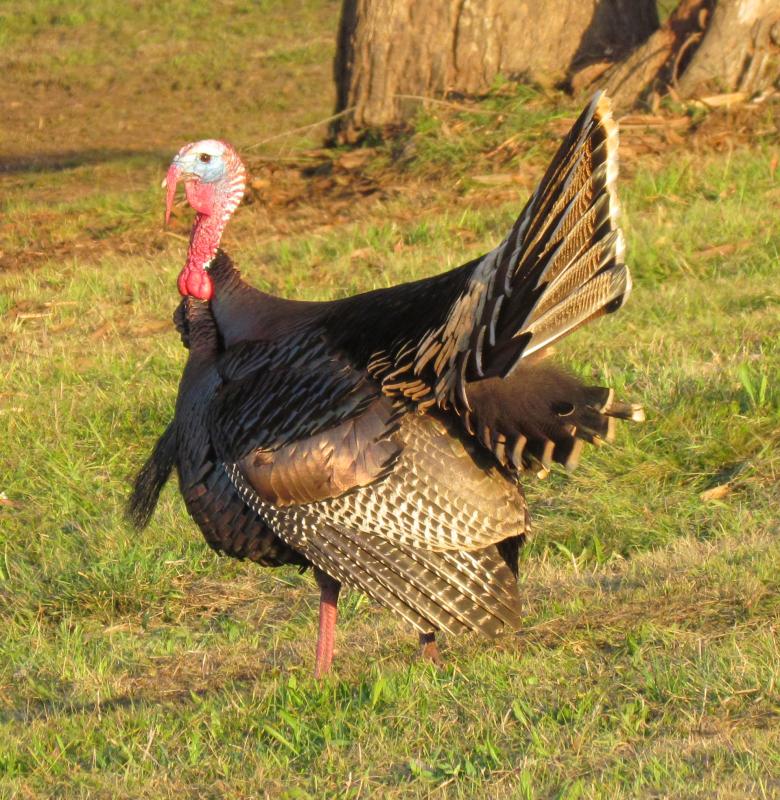The Twisted History of the Turkey’s Name
The two most well-known birds in the world would have to be—no, not Steller’s sea-eagles, albatrosses, or hummingbirds—but two species that have probably become rather mundane in most of our imaginations: the domestic chicken and the domestic turkey. It’s easy to forget that the lineages of these birds are derived originally from wild, untamed creatures whose ecological and evolutionary path intertwined with humans to change both us and them.
While both domesticated chickens and turkeys both have fascinating stories that are still being studied and elucidated through various new scientific studies, it is only fitting, given the Thanksgiving holiday upon us, that we consider the twists and turns that have brought the turkey to our tables these cool fall days, at the same time many of us are watching flocks of wild turkeys feasting under the bird feeder in the backyard.
Despite the name “turkey,” the world’s only two species of turkey both originate here in the Americas. The ocellated turkey has a rather restricted range, from the Yucatan peninsula of Mexico into adjoining regions of Guatemala and Belize. The species we know officially as the “wild turkey” has a wide range, from the southern edge of Canada across most of the U.S. into central Mexico.
Analyses of archeological remains from early Indigenous settlements, and of ancient DNA from and measurements of turkey bones found in those settlements, has shown that early Indigenous people domesticated wild turkeys several thousand years ago. Indigenous peoples in what is now the southwestern U.S. kept turkeys perhaps more for ceremonial use, including for their prized feathers, than for food, initially. Similarly, Indigenous peoples in Mexico also domesticated wild turkeys.
The early Spanish colonizers must have been rather astonished to see what to them must have looked like some version of a massive chicken being kept by the Indigenous people that they encountered and eventually brutalized. Beginning in the early 1500s, the Spanish brought back some of these turkeys with them to Spain, and people began to successfully rear them and to build larger farmed populations.
These spread from country to country across Europe over time. At some point, some of the birds were imported in England. During that time, various items that came into England from faraway places were often labeled as “Turkey” this or “Turkey.” It has been suggested that these unusual birds that were brought in were categorized in this same way and the name stuck.
A related version of the story suggests that the importers of the birds were people known in England at the time as Turkish traders. Either way, this decidedly Indigenously domesticated and geographically American bird came to be called by a name now associated with a completely unconnected part of the world.
Incidentally, in many parts of the world, the birds we call turkeys are known in various languages by what is translated to mean “Indian chickens.” This is thought to be a historical leftover from the fact that the earliest Spanish explorers to the Americas thought that they had found India. Hence, the chicken-like birds that they brought back from Mexico were called “Indian chickens.” A translation of that name is still used in many countries to refer to our very own turkey.
Early settlers to New England apparently brought some of these domesticated turkeys with them to New England where they were then surprised to find wild versions of the same birds throughout the region. In essence, they may have had the same experience that we have today when many of us enjoy a family meal that includes a cooked domestic turkey while a flock of wild turkeys struts about in the woods and fields outside.
Happy Thanksgiving!
Jeffrey V. Wells, Ph.D., is a Fellow of the Cornell Lab of Ornithology and Vice President of Boreal Conservation for National Audubon. Dr. Wells is one of the nation's leading bird experts and conservation biologists and author of the “Birder’s Conservation Handbook.” His grandfather, the late John Chase, was a columnist for the Boothbay Register for many years. Allison Childs Wells, formerly of the Cornell Lab of Ornithology, is a senior director at the Natural Resources Council of Maine, a nonprofit membership organization working statewide to protect the nature of Maine. Both are widely published natural history writers and are the authors of the popular books, “Maine’s Favorite Birds” (Tilbury House) and “Birds of Aruba, Bonaire, and Curaçao: A Site and Field Guide,” (Cornell University Press).




























